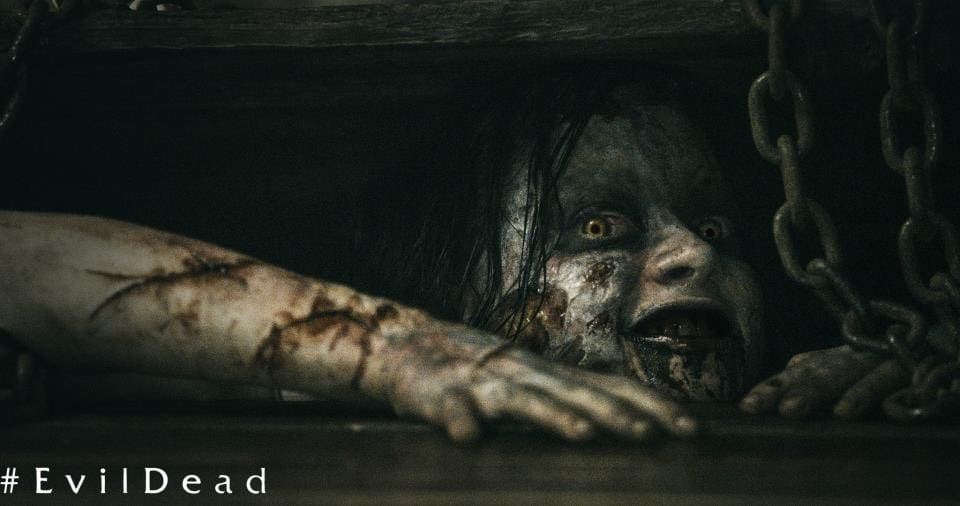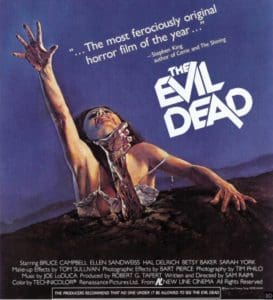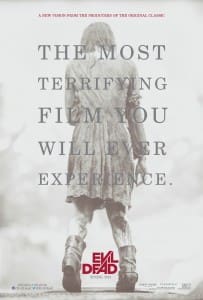Remakes of horror movies vary from instance to instance. Some may serve just as an updated adaptation of the original movie – perhaps just giving a more modern coat of paint. Others have some of the core in place, but take the story in a different direction. With audiences, these are hit or miss. Take a look at the polarizing view of 2010’s Nightmare on Elm Street. Sometimes going for a more gritty, insidious tone could sacrifice the overall heart of what made something great.
1981’s The Evil Dead directed by Sam Raimi and introducing us to the franchise champion Ash Williams (Bruce Campbell), has been subjected to an amazing cult following. The movie mixed both comedy and horror in such a way that proved that you did not need a big budget in order to make that type of movie. We’ve seen a resurgence of the “less is more approach” recently with movies like the Paranormal Activity series that started in 2007. Sometimes when you have gaudy CGI, it takes away from the practicality of the horror movie experience.
To take on a remake or update as a first time director is a daunting task. Around 2011, there was word that Fede Alvarez would be behind the director’s chair for the upcoming remake with Raimi, Campbell and Rob Tapert producing. As Alvarez co-wrote the script with Rodo Sayagues, there was question on how much would be a re-telling or something new within the Evil Dead universe.
They could have went the safe route. 2009’s Drag Me To Hell that was directed by Raimi was more in lieu of the comedy/horror line that was sent in the 1970’s Evil Dead. All bets were off with the 2013 semi-sequel update. Evil Dead is a gory, relentless, darker film that serves to be an unsettling watch both from a horror and plot standpoint. It relied more on practical effects that in some scenes, made you cringe just to see how far they would go.
Before we get into the main story, there’s a separate foreshadowing of the demon that occurs in the woods. There’s a dazed teenage that gets kidnapped, but then you find out that the demon that is the main antagonist of the story is really why that happens. A father burning his “daughter” alive and then shooting her with a shotgun is a hell of a way to introduce a movie.
In the original movie, we followed five college kids from Michigan State that went to a secluded cabin for spring break. It sets up like a quintessential movie of young people doing debauchery where they accidentally fall into the evil. A more trying issue brings the characters together in the 2013 movie. The demonic presence is not the only thing that is horrific within the movie. Real world issues can be just as scary. Abandonment, guilt, and the obstacles of drug addiction are themes that bring more reverence to the overall story this time around.
Four of the characters have a backstory and were close at one point. Olivia (Jessica Lucas), Mia (Jane Levy), David (Shiloh Fernandez), and Eric (Lou Taylor Pucci) were close knit until David decided to leave for Chicago. Natalie (Elizabeth Blackmore), David’s girlfriend is new to the situation and history. Mia and David are brother and sister and there’s obvious resentment in which their mother dies in a mental institution with only Mia there to care for her until her last days. This resentment is also shown with David and Olivia as well.
While David was gone, Mia had developed a drug addiction to heroin. Probably as a coping mechanism to both David leaving and watching her mother die. Both characters have to confront something. David is faced with a situation that he can’t run from. He can’t seek the easy way out of being in the secluded cabin while his sister is both fighting and internal and external struggle.
The isolation and Mia’s past struggles with addiction acts to cloud everyone’s judgement. Mia warns everybody of her experience in the woods, but everybody elects to stay the course of the detox against better judgement. Olivia’s background as a nurse kept the group in the cabin a little bit longer than they should have and Eric read a passage from the book that unleashed the evil. Seclusion will make you act against your better judgement.
One of the most interesting things that is done as a device in the movie is the use of light or lack there of. The only spots of sunlight you see peer through a window on old photographs, the initial meeting of Mia and David in the beginning of the movie, and sunrise once we hit the conclusion at the end.
There’s also the use of weather change. One of the first shots of the movie shows how desolate and barren the forest where the cabin is with wide shots. As the situations deteriorate, the outside area begins to manifest that. A specific instance would be when Mia is trying to escape in the woods. A thick fog begins to permeate as her mind state is very scattered and cloudy. Lighting strikes a tree where David buries Mia alive to attempt to purify her from the demon. Fire instead of water is shown as a symbol of liberation.
At the end of the movie, the color red has a duality type meaning to it. Mia is buried alive in a red dress. Red both stands for love/courage, but also violence. You have the love that both the brother and sister share. You see that he actually stays to the end instead of running. The sky rains blood as Mia fights off the abomination and uses her determination in taking the demon down.
As a “soft” reboot of the original movie, there are some homages. Naturom Demonto or the book of the dead that Eric reads from appear in both movies. However, in the 2013 version, there’s no face on the book and it doesn’t go by a name. Some of the demonic voice overs (“One by one, we will take you”) occur again. The infamous “vine” scene in where Alvarez and Raimi had some reservations adding this scene, but it’s back.
Looks and textures are everything. The dead-ites of the 2013 version make full use of the grounded elements. Gone are the creepy, heavy on makeup zombies of the 1981 version. You see every cut, every wound pulsating from skin, and every tendon that gets severed. The sound design and the visuals make for an uneasy viewing. Usual horror elements and anticipation come into play as well when a character enters a room. A creeping tension of something jumping out at you or something grotesque revealing itself is always in play.
The end of the movie almost acts like an epilogue. It feels like the main story is concluded and this is a taste of where things can go. Mia’s story arch turns from the harbinger of the demon to the complete protagonist. With the unfortunate loss of her hand, the chainsaw makes it’s triumphant return as a nod to Ash.
While we are still hoping for a fourth movie entry in the Evil Dead franchise, the 2013 proved that real life struggles can co-exist with fantasy. Both each have room within the movie to give a real sense of confusion and anxiety. With that, there’s a fine line between brutality and redemption within both can exist.




